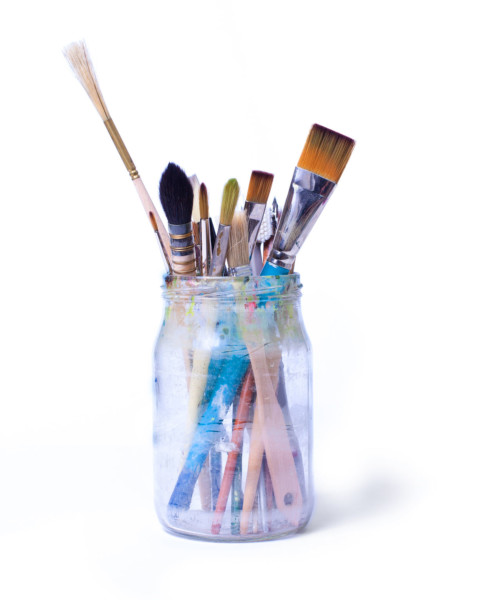What is Art Therapy?
 “Art therapy helps people express their feelings when words cannot,” explains Sarah Deaver, president of the American Art Therapy Association (AATA).
“Art therapy helps people express their feelings when words cannot,” explains Sarah Deaver, president of the American Art Therapy Association (AATA).
Art therapy is just what it sounds like. It is the combination of therapy and art, facilitated by a trained professional, to help people improve their level of functioning. It is beneficial to people who experience trauma, illness or challenges and to people who seek personal development and insight. Through creating art and reflecting on the process and results, people gain a new window into their own experience.
Art therapy uses art media, the creative process and the resulting artwork as a therapeutic and healing process.
Clients – young, old and in-between – are able to explore their feelings, reconcile emotional conflicts, foster self-awareness, manage behavior, develop social skills, improve reality orientation, reduce anxiety and increase self-esteem.
Clients come from all walks of life, facing a full array of challenges. Individuals, couples, families and groups can all benefit from various art therapy formats.
Art therapy is an effective treatment for persons experiencing developmental, medical, educational, social or psychological impairment. A key goal in art therapy is to improve or restore the client’s functioning and his/her sense of personal well being.
The process isn’t an art lesson – it is grounded in the knowledge of human development, psychological theories and counseling techniques.
Meet our Art Therapist

Laurie Moyer, LMHC, LCAC, ATR
Laurie is a registered art therapist with over 20 years of clinical experience working with children, adolescents, adults, and families.
She specializes in supportive therapy designed to meet the client’s needs utilizing a combination of therapeutic approaches.
Offering art therapy to those individuals to express their feelings when they can’t find the words, as well as offering traditional talk therapy. Laurie offers reliable therapeutic skills and the opportunity for healing through creative expression.
View more information on our Art Therapist, Laurie Moyer
Laurie is a private pay provider. Our highly experienced billing staff will electronically file claims on your behalf to maximize possible reimbursement.
FAQ’s from the website of Art Therapy Credentials Board, Inc.
Who uses art therapy?
According to the American Art Therapy Association (AATA):
“Art therapy is practiced in mental health, rehabilitation, medical, educational, forensic, wellness, private practice and community settings with diverse client populations in individual, couples, family and group therapy formats. Art therapy is an effective treatment for people experiencing developmental, medical, educational and social or psychological impairment.”
You may find art therapists working with clients in nursing homes or schools, medical practices or corporations, community organizations or with specialized groups or populations.
What does art therapy address or treat?
The American Art Therapy Association (AATA) reports:
“Individuals who benefit from art therapy include those who have survived trauma resulting from combat, abuse and natural disaster; persons with adverse physical health conditions such as cancer, traumatic brain injury, and other health disability; and persons with autism, dementia, depression and other disorders. Art therapy helps people resolve conflicts, improve interpersonal skills, manage problematic behaviors, reduce negative stress and achieve personal insight. Art therapy also provides an opportunity to enjoy the life-affirming pleasures of art making.”
How long has art therapy been around?
Art therapy as a deliberate focus and practice began in the 1940s. The British Association of Art Therapists was founded in 1964. The American Association of Art Therapists was founded in 1969.
In 1993, the Art Therapy Credentials Board (ATCB) was founded to protect the public by promoting the competent and ethical practice of art therapy. It manages the credentialing and testing processes of art therapists (in alignment with the AATA) to ensure the professional and high-caliber practice of the profession.
What is involved in art therapy?
Art therapists rely on their knowledge of the research and practice of therapy as well as specific techniques shown to be useful in specific situations. Often the process involves looking at what is included or represented in a client’s artwork – but also what is missing.
Art therapy is not an art class, although the process can involve learning art techniques and enjoying the creative process. The art therapy process is generally focused on the client’s inner world and ways to identify and express their experience or perspective.
What should I look for in an art therapist?
Look for an art therapist who has knowledge of and/or experience similar to your needs or those you are hoping to help (age, gender, nationality, circumstance, setting, etc.). Also consider the issues: trauma, disability, illness, behavioral or relationships challenges and so forth. Ask questions of your potential art therapist to understand their experience, expertise and interest.
Also ask questions about their qualifications. If you look for the ATR or ATR-BC credential you can be assured your art therapist has a high-caliber of education, training and experience. Registered Art Therapists (ATRs) have demonstrated a rigorous level of education and training. Board Certified Art Therapists (ATR-BCs) have the added credential if they pass a comprehensive national exam.
Source: https://www.atcb.org/
